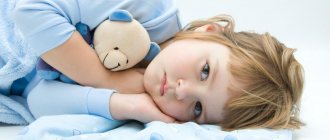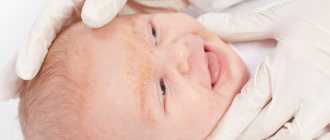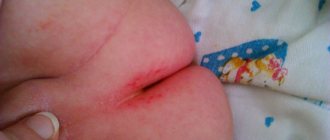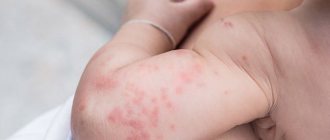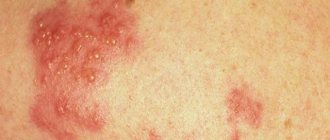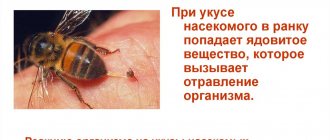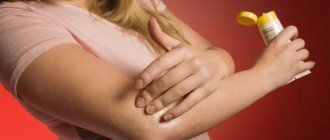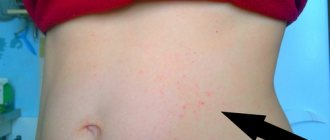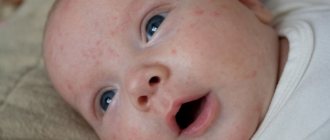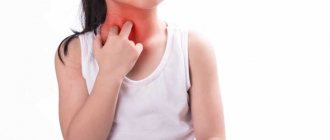What is a blister?
In principle, such an injury is not fatal, but it is unpleasant and painful. It is characterized by the appearance of a cavity-free formation on the leg or arm, which occurs due to swelling and inflammation of the upper layer of the epidermis. Blisters on the feet usually disappear after some time.
The formation can have different shapes and sizes. As for the symptoms of this pathology, they are very simple. When a blister appears, a person feels burning, itching and pain. The signs are especially obvious when the formation is touched. However, those blisters that may appear as a result of a burn cannot be considered blisters.
Types of rashes and locations on the child’s body
The rash occurs due to various reasons. It occurs with allergic reactions, infectious diseases, improper skin care, poisoning of various etiologies, insect bites, penetration of parasites into the body, mechanical stress, fungal infections, allergies. Depending on the cause of occurrence, there are different types of rashes on the body:
- spots of red, pink or white;
- pimples with clear liquid inside;
- pus-filled blisters or pustules;
- subcutaneous bumps;
- dry flaky spots;
- small bumps or papules;
- blue or red stars resembling subcutaneous hemorrhages.
Acne can be accompanied by itching, flaking and inflammation. In some cases, the skin at the site of the rash begins to crack and peel. In babies, pimples and blisters appear on the legs, arms, fingers, back, stomach, neck, face, butt (we recommend reading: why do white pimples appear on a child’s hands?). The location of the rash depends on the cause that caused it and the severity of the disease.
Reasons for the problem
Basically, they are different. However, most often blisters on the feet are observed due to friction of the skin on shoes or other objects (they can appear on the hands of athletes who practice on the uneven bars). They can also be the result of an insect bite or an allergic reaction to an irritant.
In other words, we can say that a blister is a natural protective reaction of our skin to too strong a mechanical impact. This cannot be called an allergy, since this problem can occur in absolutely anyone.
Prevention
There is no specific prevention for skin blisters, but precautions can be taken to prevent infection or damage to the skin:
- maintain personal hygiene;
- wear closed clothes outdoors or in the country;
- avoid contact with infected patients;
- follow a hypoallergenic diet;
- Take your child to the pediatrician 1-2 times a year.
If you have a specific disease, you can include additional procedures in the program according to your doctor’s recommendations. If blisters or irritation appear, it is best to make an appointment with your doctor right away.
Blisters in a child may be the result of measles, chickenpox, allergies, insect bites, or skin damage. Rashes often appear with autoimmune diseases such as arthritis or psoriasis. Laboratory diagnostics will help to accurately identify the cause; a blood test plays a decisive role. In treatment, the choice of the right drug plays an important role.
In what cases should you consult a doctor?
If you have blisters on your feet, then this is not a reason to panic. However, there are cases when consultation with a dermatologist is necessary. It is worth visiting a doctor if you experience:
- severe pain, swelling of the affected area;
- fever and fever;
- suppuration in the area of the blister;
- enlarged lymph nodes.
All these signs indicate the addition of an infection. If you have blisters on your toes, improper treatment can lead to headaches and worsening your general condition. Naturally, in this case, you must consult a doctor so as not to worsen your situation. The fact is that the frequent appearance of blisters may indicate an autoimmune disease. And this is already a serious wake-up call.
Useful video about rashes in children
List of sources:
- Dakhovsky, A. Skin diseases / A. Dakhovsky, N. Stogova. - M.: Book on Demand, 2011. - 761 p.
- Kozhevnikov, P.V. General dermatology: monograph. / P.V. Kozhevnikov. - M.: Medicine, 1990. - 296 p.
- Pavlova, O.V. Fundamentals of psychodermatology / O.V. Pavlova. - M.: LKI, 2007. -Selissky, A.B. Handbook of skin diseases / A.B. Selissky. - M.: State Publishing House of the BSSR, 2000. - 476 p. 240 c.
- Selissky, G.D. Prevention of occupational dermatoses / G.D. Selissky, B.G. Stoyanov. - M.: Medicine, 1981. - 272 p.
What types of blisters are there?
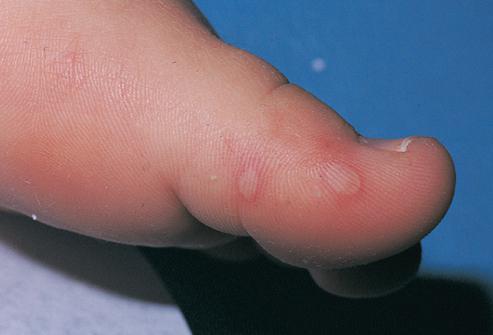
It should be noted that this problem can be classified. For example, blisters on the toes can vary.
- Reds. They usually appear during an allergic reaction to an irritant, called hives. They usually go away on their own without any treatment within a few hours.
- Mermen. They usually appear after wearing tight shoes that rub the skin too much. The inside is a transparent bubble filled with serum. It is the part of the blood that does not contain red blood cells. Most often, such blisters on the toes are a protection against deep damage to the epidermis.
- White. Most often they appear due to an allergic reaction or excessive work of the sebaceous glands. They can be localized anywhere.
First aid for the formation of a blister and features of wound treatment in children
In order to eliminate the first symptoms of blisters, which cause a lot of pain and discomfort, you need to provide yourself with first aid. First you need to clean the affected part of the skin from dust. That is, blisters on the hands and feet should be washed thoroughly. In addition, the affected area should be protected from subsequent contact with the irritating surface. That is, if you are putting on shoes, you must first put on a sock and cover the blister with an adhesive plaster.
If one layer of adhesive is not enough, apply another one. Do not pop the blister, as this can cause infection in the wound. However, if it is very large and causing a lot of discomfort, then you can drain the fluid from it using a sterile needle. However, it is better not to cut off the skin that remains, as it is a protective layer. It will take about 14 days for the blister to completely disappear.
If you notice that the rubbed area has begun to fester or your temperature has risen, then you should definitely consult a doctor, as an infection has entered the body that can cause serious complications.
Now let's look at the question of what to do if your baby rubs his leg or arm. If blisters appear on a child’s legs, first of all, you should eliminate the risk of infection of the wound, as well as relieve pain. To do this, you can use special healing ointments: Panthenol, Boro Plus and others. Clean the affected area very often with warm water and antibacterial soap.
Skin blisters caused by infectious diseases
Blisters on a child’s body are often a symptom of various infectious diseases. In this case, the rash is accompanied by other manifestations. The infectious rash may appear as single blisters or grouped pimples. By the appearance of the blisters and their location, one can judge the causative agent of the disease. Types of infectious rash with explanations:
Herpes types 1 and 2
- Nature of the rash: individual watery pimples or grouped rash. At the beginning of the disease they are filled with clear liquid, after 1-2 days they are filled with pus. They open spontaneously, and in their place long-term non-healing wounds and crusts form. Pimples are painful and itchy.
- Location: most often in the mouth, genitals and lips, but can affect other areas.
- Additional symptoms: fever, headache, inflammation of the lymph nodes, general malaise.
- Treatment: antiviral drugs, antihistamines and antipyretics.
Shingles
- The nature of the rash: a group of bubbles with transparent contents, which become cloudy on the 3-4th day. Accompanied by severe burning and pain in the affected areas. Crusts form within 2-3 weeks.
- Localization: nerve nodes on the face and head, back, back of the head, shoulders, neck, arms and legs.
- Additional symptoms: headache, temperature up to 39 degrees, disruption of the gastrointestinal tract, inflammation of the lymph nodes, weakness.
- Treatment: antiviral drugs, antihistamines and antipyretics.
Chicken pox
- Character of the rash: small blisters filled with light liquid. They itch a lot. They burst quickly and a small wound appears in their place.
- Localization: throughout the body.
- Additional symptoms: fever, rarely – cough.
- Treatment: the blisters are treated with an antiseptic and antiallergic medications are prescribed.
Streptoderma
- Nature of the rash: purulent spots or blisters up to 10 centimeters. The rash causes burning and itching.
- Localization: first on the face, then spread throughout the body.
- Additional symptoms: intoxication of the body, temperature up to 38-39 degrees, lymphadenitis.
- Treatment: antibacterial ointments, antibiotics, antipyretic drugs, hypoallergenic diet, treatment of the rash with brilliant green, boric alcohol.
Enterovirus
- Nature of the rash: blistering rash with clear liquid.
- Localization: on different parts of the body and mucous membranes.
- Additional symptoms: headache, nausea, vomiting, fever.
- Treatment: immunomodulators, antibiotics, drugs aimed at eliminating symptoms.
Pemphigus
- Character of the rash: transparent watery blisters with a red rim.
- Localization: at the beginning of the disease - in the oral cavity, then - arms, legs, abdomen.
- Additional symptoms: weakness, elevated body temperature.
- Treatment: antiviral drugs, glucocorticosteroids, antihistamines, antipyretic drugs.
- Character of the rash: blisters with a small crust. Appear at the site of infection.
- Localization: at the site of cat scratches.
- Additional symptoms: inflammation of the lymph nodes, intoxication of the body.
- Treatment: anti-inflammatory and antibacterial agents, antiallergic drugs.
Watery pimples can be caused by parasite infestation. The blistering rash on the stomach, feet and between the fingers and toes is caused by the scabies mite. The rash is very itchy, especially at night. The blisters turn into pink spots a few days after they appear. The disease is treated with external agents (for example, benzyl benzoate ointment) and antihistamines.
What to do if you feel itching at the site of the lesion?
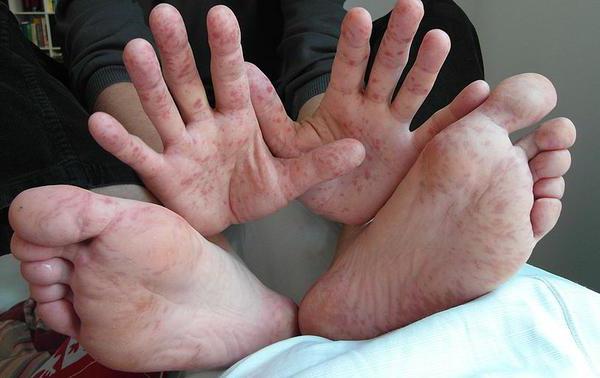
If you feel that the blisters on your legs are itching, this means that you have an allergic reaction to some irritant or that the wound has become infected. To eliminate itching, you will have to take antihistamines. The best in this case are Telfast and Claritin.
Itching can also appear in other cases, for example, during hypothermia. However, in this case it is necessary to fight using the same method. That is, in order for the affected area to stop itching, you need to put it in cool water or put a compress on it. In this case, histamine comes out due to vasoconstriction.
Features of wound treatment
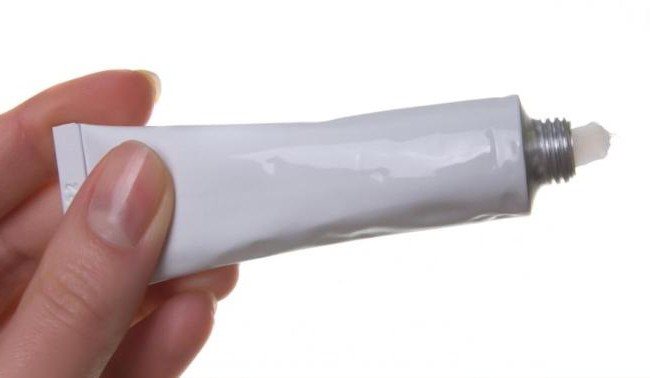
If blisters appear on your leg, they need to be treated properly. To do this, you can use both traditional and folk methods. For example, a salt water bath helps. To do this, you need to dissolve a tablespoon of salt in a liter of water. Such procedures should be taken daily.
For quick wound healing, use aloe leaves. Before using the sheet, you need to cleanse your skin. Aloe should be glued with a patch overnight. To disinfect the wound, use an infusion of chamomile or oak bark. To prepare the solution, steam 2 tablespoons of raw material with 500 ml of boiled water. After the product has infused, you can wash the affected area, take baths or apply compresses.
Preventive measures
If blisters appear on your leg, they must be treated. However, it is better to prevent their occurrence. First of all, choose shoes that are comfortable, not tight or too hard. You should also break it in before you plan to wear it on a long trip.
You should not wear clothes that make your feet wet. This only promotes chafing. If your skin is too sensitive and it easily rubs, then you need to use special fatty creams that create a protective film on the surface of the epidermis.
If you have delicate hands, but you like to work in the country, then try to wear protective gloves. Naturally, it is necessary to use creams that restore the top layer of skin.
In principle, these are all the features of the occurrence and elimination of blisters. The main thing is to prevent infection of the wound. If there are complications, it is better to consult a doctor. Be healthy!
